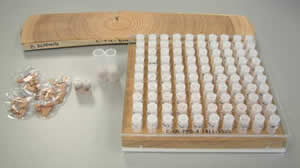
Neutron Activation Analysis (NAA)
Neutron activation analysis stands at the forefront of techniques for the quantitative multi-element analysis of major, minor, trace and rare elements. It is a non-destructive analytical technique where the sample or artifact may be returned to the researcher after analysis.
The principle involved in neutron activation analysis consists of first irradiating a sample with neutrons in a nuclear reactor to produce specific radionuclides. After the irradiation, the characteristic gamma rays emitted by the decaying radionuclides are quantitatively measured by gamma spectroscopy, where the gamma rays detected at a particular energy are indicative of a specific radionuclide's presence. Data reduction of gamma ray spectra then yields the concentrations of various elements in the samples being studied. With instrumental neutron activation analysis it is possible to measure quantitatively about 60 elements in small samples. The lower limit of detection is on the order of parts per million to parts per billion depending on the element analyzed and the activity of the bulk sample matrix.
The following table gives a list of elements that may be quantitatively analyzed using neutron activation analysis:
| Aluminum | Gadolinium | Neodymium | Sodium |
| Antimony | Gallium | Nickel | Strontium |
| Arsenic | Germanium | Niobium | Tantalum |
| Barium | Gold | Osmium | Tellurium |
| Bromine | Hafnium | Palladium | Terbium |
| Cadmium | Indium | Platinum | Thorium |
| Cerium | Iodine | Potassium | Thulium |
| Cesium | Iridium | Praseodymium | Tin |
| Chlorine | Iron | Rhenium | Titanium |
| Chromium | Lanthanum | Rubidium | Tungsten |
| Cobalt | Lutetium | Ruthenium | Uranium |
| Copper | Magnesium | Samarium | Vanadium |
| Dysprosium | Manganese | Scandium | Ytterbium |
| Erbium | Mercury | Selenium | Zinc |
| Europium | Molybdenum | Silver | Zirconium |
Applications of NAA
Neutron activation analysis, which was discovered in 1936, is one of the most potent techniques for multi-element analysis. Advances in semiconductor detector systems coupled with improvements in research reactors, especially development of the TRIGA reactor, have done much to aid the proliferation of the neutron activation analysis technique. Neutron activation analysis was one of the methods used here at Radiation Science and Engineering Center , Breazeale Nuclear Reactor to determine experimentally periods of global environmental stress during the past six thousand years using tree samples already collected and dated. Today, instrumental neutron activation analysis has found diverse application in studies requiring non-destructive analysis of samples and/or low levels of sensitivity for the elements of interest. Other potential applications of neutron activation analysis (for the trace and bulk element determination in samples) that have been performed at reactor facilities include:
* Archeology - pottery, clay samples
* Geology - basaltic rocks, K-T boundary samples
* Materials Science & Engineering - silicon based materials
* Electrical Engineering - semiconductor materials
* Nuclear Industry - electronics packages for radiation sensing devices
* Textiles - fabrics, other textiles
* Agriculture - beet pulp, lipids, hay, oil, fish
* Anthropology - obsidian, teeth, bones
* Biology - chemicals, sugar, enzymes, solutions, ants
* Botany - wheat spores
* Chemistry - oxides, salts, pure crystals, and metals residue swabs
* Engineering & Industry - pure metals, chemical compounds, oils, thin film deposits, plastic films, alloys, rocks
* Fisheries - fish, shells
* Forestry - wood, phloem, tree needles, soil
* Geology - meteorites, gems, minerals
* Medicine - water, skin, hair, nails
* Oceanography - fossils, sediments, basalts
* Pharmacy - chemicals
* Forensics - bullets, paint, glass, metals, gunshot residue swabs
Many of the above listed applications, and others, could be performed using the neutron activation analysis facilities at Radiation Science and Engineering Center . Please contact Prof. Kenan Ünlü at RSEC for details.
|


